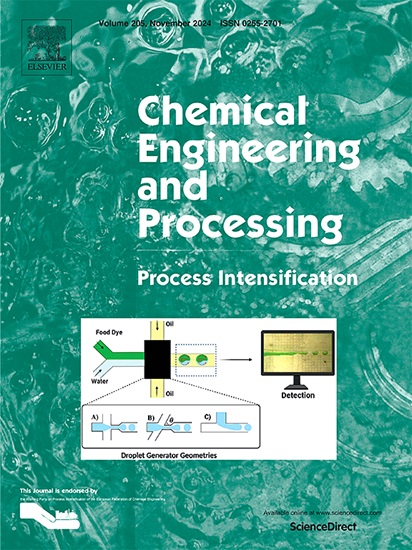疏水措施对细水雾过滤器气液聚结分离性能的影响及机理
IF 3.8
3区 工程技术
Q3 ENERGY & FUELS
Chemical Engineering and Processing - Process Intensification
Pub Date : 2025-06-24
DOI:10.1016/j.cep.2025.110424
引用次数: 0
摘要
在天然气输送中,气液聚结对防止管道和设备腐蚀起着至关重要的作用。然而,新型气液聚结滤芯排水层结构的发展仍然有限,传统排水层结构对滤芯性能的影响尚不清楚。在本研究中,利用实验平台评估了三种不同排水结构对过滤器性能的影响。采用数字图像处理技术分析了滤层内部液体分布,考察了滤层对液体流动通道的影响,阐明了滤层在过滤系统中的功能作用。实验结果表明,加入排水结构后,压降降低16%,分离效率提高12%。此外,网格状排水结构优于编织网结构,其质量因子是编织网结构的两倍。此外,将排水层放置在过滤器的中间可以提高排水效率。排水层主要通过减少液体流道数量、减小流道面积和增大流道直径来改善分离性能。本文章由计算机程序翻译,如有差异,请以英文原文为准。

Effect and mechanism of drainage measures on gas-liquid coalescence separation performance of a water mist filter
In natural gas transportation, gas-liquid coalescence plays a crucial role in preventing pipeline and equipment corrosion. However, the development of novel drainage layer structures for gas-liquid coalescence filter elements remains limited, and the impact of traditional drainage structures on filter performance is not yet well understood. In this study, an experimental platform was used to evaluate the effects of three different drainage structures on filter performance. Digital image processing techniques were employed to analyze the internal liquid distribution within the filter layers, investigating the influence of the drainage layer on liquid flow channels and elucidating its functional role in the filtration system. The experimental results indicate that the addition of the drainage structure led to a 16 % reduction in pressure drop and a 12 % improvement in separation efficiency. Furthermore, the grid-shaped drainage structure outperformed the woven net structure, demonstrating a quality factor twice as high as that of the woven net configuration. Additionally, placing the drainage layer in the middle of the filter enhances drainage efficiency. The drainage layer improves separation performance primarily by reducing the number of liquid flow channels, decreasing channel area, and increasing channel diameter.
求助全文
通过发布文献求助,成功后即可免费获取论文全文。
去求助
来源期刊
CiteScore
7.80
自引率
9.30%
发文量
408
审稿时长
49 days
期刊介绍:
Chemical Engineering and Processing: Process Intensification is intended for practicing researchers in industry and academia, working in the field of Process Engineering and related to the subject of Process Intensification.Articles published in the Journal demonstrate how novel discoveries, developments and theories in the field of Process Engineering and in particular Process Intensification may be used for analysis and design of innovative equipment and processing methods with substantially improved sustainability, efficiency and environmental performance.

 求助内容:
求助内容: 应助结果提醒方式:
应助结果提醒方式:


